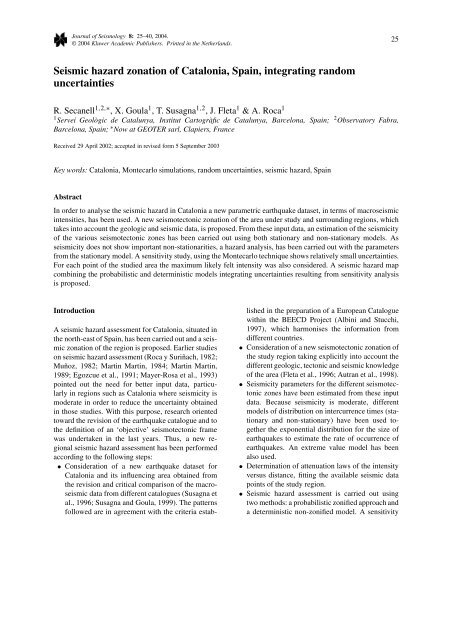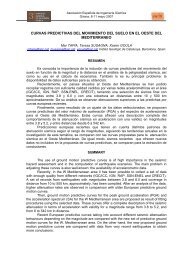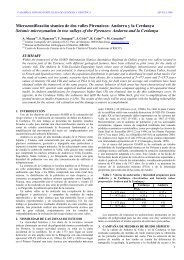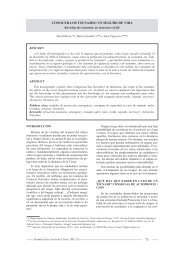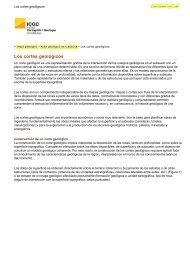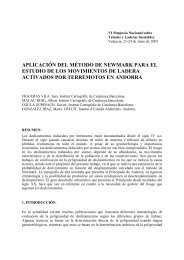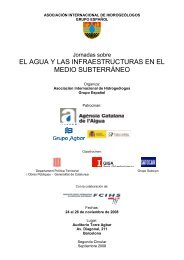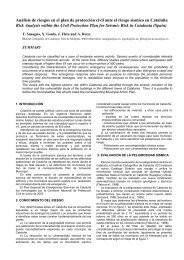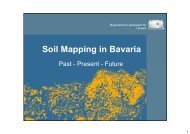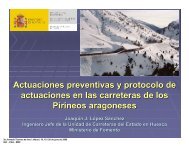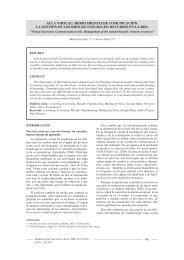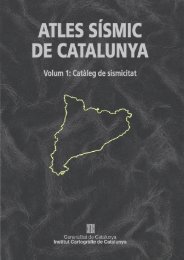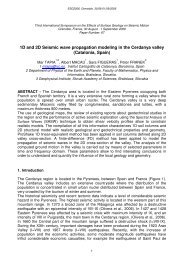Seismic hazard zonation of Catalonia, Spain, integrating random ...
Seismic hazard zonation of Catalonia, Spain, integrating random ...
Seismic hazard zonation of Catalonia, Spain, integrating random ...
You also want an ePaper? Increase the reach of your titles
YUMPU automatically turns print PDFs into web optimized ePapers that Google loves.
Journal <strong>of</strong> Seismology 8: 25–40, 2004.<br />
© 2004 Kluwer Academic Publishers. Printed in the Netherlands.<br />
25<br />
<strong>Seismic</strong> <strong>hazard</strong> <strong>zonation</strong> <strong>of</strong> <strong>Catalonia</strong>, <strong>Spain</strong>, <strong>integrating</strong> <strong>random</strong><br />
uncertainties<br />
R. Secanell 1,2,∗ ,X.Goula 1 , T. Susagna 1,2 , J. Fleta 1 &A.Roca 1<br />
1 Servei Geològic de Catalunya, Institut Cartogràfic de Catalunya, Barcelona, <strong>Spain</strong>; 2 Observatory Fabra,<br />
Barcelona, <strong>Spain</strong>; ∗ Now at GEOTER sarl, Clapiers, France<br />
Received 29 April 2002; accepted in revised form 5 September 2003<br />
Key words: <strong>Catalonia</strong>, Montecarlo simulations, <strong>random</strong> uncertainties, seismic <strong>hazard</strong>, <strong>Spain</strong><br />
Abstract<br />
In order to analyse the seismic <strong>hazard</strong> in <strong>Catalonia</strong> a new parametric earthquake dataset, in terms <strong>of</strong> macroseismic<br />
intensities, has been used. A new seismotectonic <strong>zonation</strong> <strong>of</strong> the area under study and surrounding regions, which<br />
takes into account the geologic and seismic data, is proposed. From these input data, an estimation <strong>of</strong> the seismicity<br />
<strong>of</strong> the various seismotectonic zones has been carried out using both stationary and non-stationary models. As<br />
seismicity does not show important non-stationarities, a <strong>hazard</strong> analysis, has been carried out with the parameters<br />
from the stationary model. A sensitivity study, using the Montecarlo technique shows relatively small uncertainties.<br />
For each point <strong>of</strong> the studied area the maximum likely felt intensity was also considered. A seismic <strong>hazard</strong> map<br />
combining the probabilistic and deterministic models <strong>integrating</strong> uncertainties resulting from sensitivity analysis<br />
is proposed.<br />
Introduction<br />
A seismic <strong>hazard</strong> assessment for <strong>Catalonia</strong>, situated in<br />
the north-east <strong>of</strong> <strong>Spain</strong>, has been carried out and a seismic<br />
<strong>zonation</strong> <strong>of</strong> the region is proposed. Earlier studies<br />
on seismic <strong>hazard</strong> assessment (Roca y Suriñach, 1982;<br />
Muñoz, 1982; Martin Martin, 1984; Martin Martin,<br />
1989; Egozcue et al., 1991; Mayer-Rosa et al., 1993)<br />
pointed out the need for better input data, particularly<br />
in regions such as <strong>Catalonia</strong> where seismicity is<br />
moderate in order to reduce the uncertainty obtained<br />
in those studies. With this purpose, research oriented<br />
toward the revision <strong>of</strong> the earthquake catalogue and to<br />
the definition <strong>of</strong> an ‘objective’ seismotectonic frame<br />
was undertaken in the last years. Thus, a new regional<br />
seismic <strong>hazard</strong> assessment has been performed<br />
according to the following steps:<br />
• Consideration <strong>of</strong> a new earthquake dataset for<br />
<strong>Catalonia</strong> and its influencing area obtained from<br />
the revision and critical comparison <strong>of</strong> the macroseismic<br />
data from different catalogues (Susagna et<br />
al., 1996; Susagna and Goula, 1999). The patterns<br />
followed are in agreement with the criteria established<br />
in the preparation <strong>of</strong> a European Catalogue<br />
within the BEECD Project (Albini and Stucchi,<br />
1997), which harmonises the information from<br />
different countries.<br />
• Consideration <strong>of</strong> a new seismotectonic <strong>zonation</strong> <strong>of</strong><br />
the study region taking explicitly into account the<br />
different geologic, tectonic and seismic knowledge<br />
<strong>of</strong> the area (Fleta et al., 1996; Autran et al., 1998).<br />
• <strong>Seismic</strong>ity parameters for the different seismotectonic<br />
zones have been estimated from these input<br />
data. Because seismicity is moderate, different<br />
models <strong>of</strong> distribution on intercurrence times (stationary<br />
and non-stationary) have been used together<br />
the exponential distribution for the size <strong>of</strong><br />
earthquakes to estimate the rate <strong>of</strong> occurrence <strong>of</strong><br />
earthquakes. An extreme value model has been<br />
also used.<br />
• Determination <strong>of</strong> attenuation laws <strong>of</strong> the intensity<br />
versus distance, fitting the available seismic data<br />
points <strong>of</strong> the study region.<br />
• <strong>Seismic</strong> <strong>hazard</strong> assessment is carried out using<br />
two methods: a probabilistic zonified approach and<br />
a deterministic non-zonified model. A sensitivity
26<br />
analysis <strong>of</strong> the probabilistic assessment has been<br />
carried out in order to investigate the influence <strong>of</strong><br />
the uncertainty <strong>of</strong> parameter values on the stability<br />
<strong>of</strong> the results. A Monte-Carlo method is used to<br />
determine the confidence <strong>of</strong> the results.<br />
• Finally, a seismic <strong>hazard</strong> <strong>zonation</strong> associated to a<br />
return period <strong>of</strong> 500 years combining the most representative<br />
facts <strong>of</strong> both approaches is proposed.<br />
In this paper the <strong>hazard</strong> assessment was produced in<br />
terms <strong>of</strong> epicentral intensity for two main reasons.<br />
First the earthquake database, and in particular the<br />
recent revision <strong>of</strong> the Catalan catalogue, is available<br />
in MSK epicentral intensities and many intensities<br />
data points are available and useful to propose attenuation<br />
relations. Second, this study is a first step <strong>of</strong> a<br />
complete seismic risk assessment that was carried out<br />
in our region for emergency plan purposes. Most <strong>of</strong><br />
the available ground motion-vulnerability-damage relationships<br />
are in terms <strong>of</strong> macroseismic intensities as<br />
available damage observations are usually interpreted<br />
in terms <strong>of</strong> intensity. It would be correct to correlate<br />
PGA to percentage <strong>of</strong> damage through vulnerability<br />
but, as PGA data are scarce, intensity can be used as a<br />
rough ground motion indicator and fragility curves are<br />
expressed by intensity.<br />
Input data<br />
In order to analyse the seismic <strong>hazard</strong> for <strong>Catalonia</strong> a<br />
good earthquake dataset needs to be made both <strong>of</strong> information<br />
from this region and from the surroundings<br />
(Figure 1), including two areas which could contribute<br />
to the seismic <strong>hazard</strong> <strong>of</strong> <strong>Catalonia</strong>: the South-Eastern<br />
part <strong>of</strong> <strong>Spain</strong> (zone D in Figure 1), and the South <strong>of</strong><br />
France (zone C in Figure 1). The working file used in<br />
this work contains parametric data <strong>of</strong> each earthquake<br />
according to the following information source.<br />
1. For <strong>Catalonia</strong> (zone A in Figure 1) the seismic<br />
information has been obtained from a new earthquake<br />
catalogue (Susagna and Goula, 1999). This<br />
new catalogue contains information from earlier<br />
earthquake catalogues (IGN, 1991; BRGM-CEA-<br />
EDF, 1994; Fontserè and Iglésies, 1971; Suriñach<br />
and Roca, 1982). A critical comparison (Susagna<br />
et al., 1996) <strong>of</strong> the different information sources,<br />
together with the inclusion <strong>of</strong> specific studies on<br />
historical seismicity (Olivera et al., 1994; Susagna<br />
et al., 1994), lead to the creation <strong>of</strong> this new revised<br />
catalogue for the study area. Special effort<br />
was devoted to the revision <strong>of</strong> earthquakes with<br />
epicentre near the border line between <strong>Spain</strong> and<br />
France. The catalogue contains information about<br />
800 earthquakes catalogued with different quality<br />
index. About 200 <strong>of</strong> them have epicentral intensity<br />
values equal or greater than V. This is the minimum<br />
value <strong>of</strong> intensity considered in this seismic <strong>hazard</strong><br />
analysis.<br />
2. For the Iberian Peninsula out <strong>of</strong> zone A (zones<br />
B and D in Figure 1), the catalogue used is the<br />
IGN (1991) completed with the work from Bisbal<br />
(1984).<br />
3. Finally, for the Pyrenees out <strong>of</strong> zone A (zone<br />
C in Figure 1) the catalogues used are the IGN<br />
(1991) and the French working file BRGM-CEA-<br />
EDF (1994). To resume, the priority order used to<br />
make the catalogue was the following: 1) zone A,<br />
2) zone C, 3) zone D and finally, 4) zone B.<br />
For the evaluation <strong>of</strong> seismic <strong>hazard</strong> a seismotectonic<br />
<strong>zonation</strong> has been adopted because the knowledge on<br />
active faults is poor. The basic hypothesis is that the<br />
heterogeneity <strong>of</strong> the continental crust could explain the<br />
distribution and other characteristics <strong>of</strong> seismicity.<br />
For this first step the methodology proposed by<br />
Grellet et al. (1993) has been applied which is based<br />
on the analysis and mapping <strong>of</strong> different geological<br />
aspects, named themes in this approach. Some modifications<br />
in the methodology have been introduced due<br />
to differences <strong>of</strong> scale and geological context. The<br />
variations <strong>of</strong> different parameters for selected themes<br />
allow homogeneous tectonic zones to be identified<br />
(Fleta et al., 1996). Thus, the tectonic <strong>zonation</strong> is<br />
the first step that has been applied taking into account<br />
the more representative parameters <strong>of</strong> the crustal<br />
structure, mainly coming from the inherited geological<br />
structures.<br />
A seismotectonic <strong>zonation</strong> was obtained, for probabilistic<br />
analysis purposes, from the tectonic <strong>zonation</strong>,<br />
complemented by the seismicity distribution. Only<br />
three <strong>of</strong> the eleven seismotectonic zones (num. 7, 10<br />
and 11 on Figure 2) are defined by a simple seismicity<br />
distribution criteria. The epicentres <strong>of</strong> all earthquakes<br />
considered with the eleven seismotectonic zones proposed<br />
are shown in Figure 2. For the border area<br />
between <strong>Spain</strong> and France the zones proposed are in<br />
agreement with the preliminary zones established in<br />
France (Autran et al., 1998).
Figure 1. Geographic situation <strong>of</strong> the region considered. A = study zone; B, C, D = zones contributing to the seismic <strong>hazard</strong> <strong>of</strong> the study zone.<br />
27
28<br />
Figure 2. Seismotectonic <strong>zonation</strong> <strong>of</strong> <strong>Catalonia</strong> and the surroundings and epicentres <strong>of</strong> all the earthquakes considered. Zones defined on the<br />
basis <strong>of</strong> seismicity are represented by dashed borders.<br />
<strong>Seismic</strong> occurrence models<br />
The analysis <strong>of</strong> the seismicity has been carried out<br />
fitting various seismic occurrence models to the available<br />
seismic data for each seismotectonic zone. A stationary<br />
Poisson model was used as intercurrence time<br />
distribution and was combined with an exponential<br />
magnitude distribution. This leads to a Gutenberg-<br />
Richter distribution <strong>of</strong> seismicity. Secondly, a nonstationary<br />
Poisson model was used. This model considers<br />
the Poisson parameter depending on time, λ(t).<br />
Finally, two Gumbel (1954) distributions, Gumbel I<br />
and Gumbel III, have been also fitted.<br />
A completeness study <strong>of</strong> the seismic catalogue has<br />
been carried out analysing the number <strong>of</strong> earthquakes<br />
<strong>of</strong> each intensity level that occurred in different periods<br />
<strong>of</strong> time starting from the present days and going<br />
back in time to the 13 th century. The analysis <strong>of</strong> the<br />
completeness has been made, basically, with a visual<br />
analysis <strong>of</strong> the graphics <strong>of</strong> the seismicity <strong>of</strong> each zone.<br />
It is considered as the complete period, the period<br />
which first shows an earthquake rate decay. The max-
29<br />
Table 1. Complete periods in years (counting from present time backward) for the different intensities recorded in each zone studied<br />
INTENSITY ZONE 1 ZONE 2 ZONE 4 ZONE 5 ZONE 6 ZONE 7 ZONE 8 ZONE 9 ZONE 10 ZONE 11<br />
IV,IV-V 100 100 100 100 100 100 100 150 100 100<br />
V,V-VI 100 100 150 150 150 100 100 150 150 150<br />
VI,VI-VII 150 150 200 200 250 150 250 250 200 200<br />
VII,VII-VIII 250 250 250 750 – 250 400 400 250 750<br />
VIII,VIII-IX – 750 750 750 – 400 750 – 750 750<br />
IX,IX-X – – 750 – – – – – 750 –<br />
X,X-XI – – – – – – – – 750 –<br />
imum period considered is 750 years for the complete<br />
catalogue.<br />
This completeness study is performed for each<br />
zone. It is possible to observe that periods <strong>of</strong> completeness<br />
obtained depend on the different circumstances<br />
<strong>of</strong> each zone. Thus, for low levels <strong>of</strong> intensity, for<br />
example, more populated zones have a period <strong>of</strong> completeness<br />
longer than less populated zones. The resulting<br />
completeness periods for each zone are shown in<br />
Table 1. In zone 3 and in the background zone (zone<br />
0) there are not enough data to perform this analysis.<br />
We used a catalogue with aftershocks because we give<br />
a higher importance to the energy released than to the<br />
temporal dependence <strong>of</strong> the seismicity. This is a seismicity<br />
moderate region where the aftershocks are not<br />
very <strong>of</strong>ten.<br />
Renewal process<br />
Combining a stationary Poisson process for the intercurrence<br />
times, and an exponential distribution <strong>of</strong><br />
magnitudes, we obtain the first model fitted (Goula<br />
and Godefroy, 1985):<br />
Pr(I ≥ i) = α ∗ (exp(−β ∗ (i − i 0 ))<br />
−exp(−β ∗ (I max − i 0 )))/<br />
(1 − (exp(−β ∗ (i max − i 0 )))<br />
where Pr(I ≥ i) is the annual probability <strong>of</strong> exceeding,<br />
or being equal, a value <strong>of</strong> the intensity i, i 0 is the<br />
minimum epicentral intensity considered, i max is the<br />
maximum epicentral intensity allowed in each zone, α<br />
is the mean annual activity rate for intensities greater<br />
or equal to i 0 ,andβ is a parameter related to the slope<br />
<strong>of</strong> the Gutenberg-Richter law. The minimum intensity<br />
considered in this study is V (M.S.K.). The maximum<br />
intensity allowed in each seismic zone is imposed according<br />
to the seismic conditions <strong>of</strong> each source zone:<br />
i max values are deduced from the maximum observed<br />
Figure 3. Truncated Gutenberg-Richter law for zone 4 (mean curve<br />
± standard deviation). Squares represents observed number <strong>of</strong><br />
earthquakes per year for each intensity degree.<br />
intensity, for each zone, increasing one degree except<br />
for zone 7 where observed intensity is increased by<br />
two degrees because <strong>of</strong> the high level <strong>of</strong> seismicity and<br />
the short period <strong>of</strong> available data in this zone.<br />
<strong>Seismic</strong>ity parameters α and β were computed following<br />
the maximum likelihood method proposed by<br />
Weichert (1980). Table 2 shows, for each zone, its surface<br />
in km 2 and the corresponding values <strong>of</strong> α and β<br />
(mean values and standard deviations) and i max .The<br />
most actives zones are the central Pyrenees (Zone 7)
30<br />
Table 2. Parameters <strong>of</strong> truncated Gutenberg-Richter relation for each seismotectonic zone;<br />
α and σ (α) are the mean value and standard deviation <strong>of</strong> the activity rate on number <strong>of</strong><br />
earthquakes per year; β and σ (β) mean value and standard deviation <strong>of</strong> the negative exponential<br />
parameter related to the slope <strong>of</strong> the Gutenberg-Richter relation; Imax, the maximum<br />
epicentral intensity assigned to each zone<br />
Surface (km 2 ) α σ(α) β σ(β) h i min i max<br />
ZONE 1 14100 0.100 0.030 1.864 0.559 7 V VIII<br />
ZONE 2 4600 0.128 0.033 1.608 0.324 7 V IX<br />
ZONE 4 16300 0.157 0.030 1.256 0.186 10 V X<br />
ZONE 5 23100 0.040 0.014 1.319 0.373 10 V IX<br />
ZONE 6 8000 0.099 0.025 1.977 0.640 10 V VII<br />
ZONE 7 7200 0.957 0.090 1.420 0.116 15 V X<br />
ZONE 8 7700 0.218 0.040 1.716 0.246 15 V IX<br />
ZONE 9 9600 0.070 0.020 1.737 0.214 10 V VIII<br />
ZONE 10 19700 0.635 0.059 1.201 0.083 10 V XI<br />
ZONE 11 40100 0.060 0.016 0.886 0.242 10 V IX<br />
and the zone 10 (situated outside <strong>Catalonia</strong>). Special<br />
attention is given to zones 1, 2 and 4 due to the fact<br />
that a great part <strong>of</strong> the population <strong>of</strong> <strong>Catalonia</strong> lives<br />
there. Figure 3 shows an example <strong>of</strong> fitting the truncated<br />
Gutenberg-Richter model to the seismic data <strong>of</strong><br />
Zone 4.<br />
Extreme value models<br />
In order to test another way to estimate the parameters<br />
<strong>of</strong> the occurrence model, we used the extreme value<br />
law, widely used in the literature, that conceptually<br />
represents the same process but in practice, only the<br />
largest earthquakes are used.<br />
The extreme-value, Gumbel I, distribution (Gumbel,<br />
1954, 1958) was used:<br />
G 1 n (z) = exp[−exp(−β G(z − u))],<br />
where z is the variable related to the <strong>hazard</strong> (intensity),<br />
G(z) is the distribution function and β G and u<br />
are the parameters <strong>of</strong> the function (Epstein and Lomnitz,<br />
1966; Secanell, 1999). These parameters were<br />
obtained using a linear regression analysis.<br />
Gumbel III distribution (Gumbel, 1954, 1958) was<br />
also fitted to the data:<br />
( ) )<br />
w − z<br />
k<br />
G 3 n<br />
(−<br />
(z) = exp ,<br />
w − U<br />
where w, K and U are the parameters <strong>of</strong> the function.<br />
The parameter w is related to the maximum intensity<br />
expected to occur in a region and was fixed to<br />
be equal to i max in each seismotectonic source considered.<br />
The other parameters were obtained using a<br />
linear regression analysis.<br />
In order to fit Gumbel I and Gumbel III distributions<br />
to the seismic data, the original method proposed<br />
by Gumbel (1954) using intensities (Roca et al., 1984)<br />
has been applied. The observed extreme values <strong>of</strong> epicentral<br />
intensities, I i ,i=1,..., N, corresponding to the<br />
N time intervals <strong>of</strong> length t in which the sample is divided,<br />
have been ordered in increasing size: I 1 ≤ I 2 ≤<br />
...≤ I j ≤ ...≤ I N and ‘plotting points’ G j , computing<br />
using the original rule G j =G(I j ) = j /N+1, where j =<br />
1, ..., N (Gumbel, 1954). It is necessary to take into<br />
account two parameter estimations: the time interval<br />
duration and how the empty intervals have to be taken<br />
into account. Different time interval durations (5, 10,<br />
20, 50 years) were used to fit the available data. Long<br />
time intervals do not provide enough data and short<br />
time intervals increase the problem <strong>of</strong> empty intervals.<br />
The analysis shows that the best fit to the available data<br />
is obtained when the time interval is fixed to 10 years<br />
(Secanell, 1999).<br />
Concerning empty intervals different kind <strong>of</strong> estimations<br />
are possible as to eliminate empty time<br />
intervals or to replace the time intervals with the minimum<br />
observed intensities. After a sensitivity analysis<br />
using different time intervals (Secanell, 1999), it was<br />
proved that the best solution was obtained assigning<br />
to the empty time intervals the minimum observed<br />
intensity in each seismotectonic zone.<br />
Figure 4 shows the comparison between the activity<br />
rates (number <strong>of</strong> earthquakes per year) obtained<br />
using the extreme value method and the Gutenberg-
31<br />
Figure 4. Comparison between the seismicity rates given by renewal<br />
process, Gumbel I and Gumbel III models for zone 4.<br />
Richter law for a particular seismotectonic zone. It can<br />
be seen that there are no great differences among the<br />
different distributions, except for the largest intensities,<br />
around i max value.<br />
Non stationary models<br />
The non-stationary Poisson model proposed by Savy<br />
(1978) and modified by Hong and Guo (1995) has<br />
been applied. The model proposes a temporal occurrence<br />
<strong>of</strong> earthquakes following a Poisson law including<br />
a temporal dependence <strong>of</strong> the mean occurrence.<br />
This temporal dependence in the parameter <strong>of</strong> Poisson,<br />
λ(t), gives to the model the name <strong>of</strong> non-stationary<br />
Poisson model. Thus, when a large period <strong>of</strong> time has<br />
elapsed without the occurrence <strong>of</strong> a great earthquake,<br />
its probability <strong>of</strong> occurrence is larger than in the years<br />
following a major event.<br />
The counting process proposed by this model is<br />
based on the assumption <strong>of</strong> independent increments<br />
and, at most, one occurrence at any instant <strong>of</strong> time.<br />
It differs from a stationary Poisson model by the fact<br />
<strong>of</strong> having a varying average occurrence time. In this<br />
type <strong>of</strong> model, the number <strong>of</strong> arrivals in the time interval<br />
(t 1 ,t 2 ), N(t 2 )-N(t 1 ), is a <strong>random</strong> variable with a<br />
probability mass function (Hong and Guo, 1995):<br />
t2<br />
t 1<br />
γ(τ)dτ<br />
p[N(t 2 ) − N(t 1 ) = n] =<br />
n!<br />
⎛ ⎞<br />
t 2<br />
∗exp ⎝− γ(τ)dτ⎠<br />
t 1<br />
where the activity rate, γ , and the return period, T, are<br />
time dependent:<br />
γ(t)= µλt λ−1<br />
1<br />
T(t)=<br />
µλt λ−1<br />
The mean and the standard deviation are used to<br />
determine the parameters µ and λ.<br />
The initial idea was to carry out such analysis<br />
in every seismotectonic zone, when the data were<br />
sufficient. Therefore, a dynamic map <strong>of</strong> earthquake<br />
occurrence and, in consequence, a dynamic <strong>hazard</strong><br />
map should be obtained. The results show that only<br />
the analyses with intensities equal to or larger than VI<br />
are possible. However, the standard deviations are, in<br />
these cases, large. This fact is due to the lack <strong>of</strong> data<br />
when working with individual seismotectonic zones.<br />
In order to avoid large errors, an analysis for<br />
the whole Catalan territory was carried out. Then<br />
the period <strong>of</strong> recurrence for only intensity VIII was<br />
studied.<br />
Figure 5 shows the variation <strong>of</strong> the return periods<br />
obtained with the non-stationary Poisson model<br />
for different times elapsed since the occurrence <strong>of</strong> the<br />
last earthquake <strong>of</strong> intensity VIII. It can be noticed<br />
that, for the years following a major earthquake, the<br />
return period for an earthquake <strong>of</strong> the considered intensity<br />
is very long. This shows a low probability <strong>of</strong><br />
occurrence <strong>of</strong> earthquakes after a big one, as expected.<br />
However, it can be noticed that the return period<br />
decreases slowly when the time elapsed since the last<br />
event increases with a near asymptotic trend to 85<br />
years (which is the return period obtained through<br />
Gutenberg-Richter approach), i.e. the return period becomes<br />
independent <strong>of</strong> the elapsed time since the last<br />
event. Therefore, our catalogue gives evidence <strong>of</strong> a<br />
stationary behaviour.<br />
From the analysis and comparison among the different<br />
occurrence models it is possible to deduce<br />
that:
32<br />
Figure 5. Variation <strong>of</strong> the return periods obtained with the non stationary Poisson model for different times elapsed since the occurrence <strong>of</strong> the<br />
last earthquake <strong>of</strong> intensity VIII, or greater, for the whole area <strong>of</strong> study.<br />
• The truncated Gutenberg-Richter model can be<br />
applied to almost all seismotectonic sources.<br />
• The extreme value models and the non stationary<br />
model can only be applied to the seismotectonic<br />
sources where there are enough data.<br />
• The results obtained using extreme value models<br />
have a great variability depending on the input<br />
parameters used. In particular, the time intervals<br />
and the way that empty intervals are considered<br />
(deleting them or fixing an arbitrary intensity).<br />
• In spite <strong>of</strong> above mentioned uncertainty, the mean<br />
values <strong>of</strong> obtained parameters using Gumbel I,<br />
Gumbel III and renewal process models lead to<br />
similar values <strong>of</strong> return periods associated to different<br />
intensities (except for major intensities)<br />
(Figure 4).<br />
• The application <strong>of</strong> a non-stationary model shows<br />
an almost stationary behaviour for the seismicity<br />
<strong>of</strong> the whole territory.<br />
For these reasons, the truncated Gutenberg-Richter<br />
model has been used to estimate, for each seismotectonic<br />
zone, the seismicity parameters (α, β, h and<br />
I max ) to be considered for probabilistic seismic <strong>hazard</strong><br />
assessment.<br />
Attenuation laws and seismic <strong>hazard</strong> assessment<br />
It is well known that a crucial point in seismic <strong>hazard</strong><br />
assessment is how to consider the attenuation process.<br />
In this study attenuation has been adapted to each<br />
seismotectonic zone.<br />
The attenuation law used is the model proposed by<br />
Sponheuer (1960):<br />
(√<br />
I 0 − I = k ∗ log (r 2 + h 2 )/h<br />
(√ )<br />
+k ∗ γ ∗ loge r 2 + h 2 − h<br />
where I 0 is the epicentral intensity, I the intensity value<br />
at a site located at epicentral distance r, h the focal<br />
depth, b the geometrical spreading parameter, γ the<br />
anelastic attenuation coefficient and k is a factor relating<br />
intensity to the logarithm <strong>of</strong> the ground motion<br />
amplitude. The model was applied to the available felt<br />
intensities <strong>of</strong> 100 moderate earthquakes that occurred<br />
in the 20 th century and to the felt intensities maps<br />
<strong>of</strong> four major and well-documented historical earthquakes<br />
<strong>of</strong> the study area, mainly from the middle age<br />
(Secanell, 1998, 1999 and Ambraseys, 1985). These<br />
studies fixed the values <strong>of</strong> the parameters b and k equal<br />
to 1 and 3 respectively (Sponheuer, 1960). We have<br />
preferred to fix two parameters, b and k, and obtain<br />
a good control <strong>of</strong> the other parameters (h and γ )than<br />
) b
33<br />
to fit three parameters and to have a great uncertainty<br />
on them. As an example, the fit <strong>of</strong> the attenuation law<br />
to the data points for the earthquake occurred the 19 th<br />
<strong>of</strong> November <strong>of</strong> 1923 (from Susagna et al., 1994) is<br />
showninFigure6.<br />
The obtained focal depths for the totality <strong>of</strong> fitted<br />
laws range between 5 and 15 km and very low values<br />
(∼0.001 km −1 )<strong>of</strong>γ attenuation parameter are<br />
obtained.<br />
The observed lower attenuation for some <strong>of</strong> the<br />
earthquakes that occurred in the Pyrenees is due to<br />
their higher depth in zones 4, 7 and 8; in these regions<br />
depth is supposed to vary between 10 and 15 km while<br />
for the rest <strong>of</strong> the zones the depth is supposed to range<br />
from 5 to 10 km. This choice is supported by geological<br />
and instrumental seismic data, by the analysis <strong>of</strong><br />
attenuation data points and attenuation data maps <strong>of</strong><br />
well-documented earthquakes and, finally, some studies<br />
made in France give to these zones a similar depth<br />
that we used (Autran et al., 1998).<br />
The anelastic attenuation used was finally γ =<br />
0.001 km −1 for all zones except for zone 10,<br />
where a greater value was applied. The value γ =<br />
0.001 km −1 was already proposed by several earlier<br />
studies (Susagna et al., 1994; Secanell et al., 1996).<br />
The higher anelastic attenuation arbitrarily imposed<br />
(γ =0.1km −1 ) to the zone 10 corresponding to the<br />
South <strong>of</strong> <strong>Spain</strong> is due to the fact that no earthquake that<br />
occurred in this zone has ever been felt in <strong>Catalonia</strong>.<br />
With the attenuation law adapted for each seismotectonic<br />
zone, seismic <strong>hazard</strong> assessment was<br />
carried out using two models: a deterministic nonzonified<br />
method and a probabilistic zonified method.<br />
<strong>Seismic</strong> <strong>hazard</strong> maps based on both methods are<br />
proposed.<br />
The maximum felt intensity map is obtained applying<br />
the attenuation relation to every earthquake<br />
existing in the catalogue, then computing for each grid<br />
point the maximum derived intensity. No attenuation<br />
was considered around the epicenter up to distances<br />
(R o ) between 2 and 10 km depending on the intensity<br />
<strong>of</strong> the event to take into account the seismic source size<br />
in cases <strong>of</strong> high epicentral intensities (major events).<br />
The resulting map is presented in Figure 7 and<br />
shows the maximum intensity likely historically felt<br />
in each point <strong>of</strong> <strong>Catalonia</strong>.<br />
The procedure used for the probabilistic assessment<br />
is essentially based on the Cornell method<br />
(1968), later modified by McGuire (1976) and adapted<br />
by Goula and Godefroy (1985) for using the<br />
Sponheuer attenuation law and a truncated Gutenberg-<br />
Richter recurrence model. <strong>Seismic</strong>ity is considered<br />
distributed on homogeneous seismic sources, each<br />
<strong>of</strong> them characterised by the seismicity parameters<br />
defined in Table 2.<br />
The probabilistic seismic <strong>hazard</strong> map presented in<br />
Figure 8 shows the intensity level (as a continuous<br />
parameter) corresponding to a return period <strong>of</strong> 500<br />
years. The obtained intensities range from less than<br />
VI in the South to VII-VIII in the Northwest part <strong>of</strong><br />
<strong>Catalonia</strong>.<br />
It is important to remark that the <strong>random</strong> uncertainties<br />
on attenuation laws are integrated in the<br />
computation process. A standard deviation equal to<br />
0.5 degrees <strong>of</strong> intensity was used in our calculation<br />
process.<br />
Random uncertainty analysis<br />
A sensitivity analysis has been carried out in order to<br />
investigate the influence <strong>of</strong> the uncertainty <strong>of</strong> the input<br />
parameters on the stability <strong>of</strong> the results <strong>of</strong> the probabilistic<br />
method. For this purpose a Monte-Carlo method<br />
has been applied.<br />
For each seismotectonic zone the parameters controlling<br />
the seismicity were considered as probability<br />
distribution functions in the following way:<br />
• α and β are considered as <strong>random</strong> variables following<br />
a Gaussian probability distributions with<br />
the mean and standard deviation values already<br />
presented in Table 2.<br />
• Depth, h, and distance without attenuation, R 0 ,are<br />
considered as <strong>random</strong> variables following Gaussian<br />
probability distributions. The mean value <strong>of</strong><br />
the depth corresponds to the value used to determine<br />
the seismic <strong>hazard</strong> and the standard deviation is<br />
considered to be equal to 5 km. The mean value R 0<br />
corresponds to the value used in the <strong>hazard</strong> assessment<br />
and standard deviation <strong>of</strong> R 0 is taken equal<br />
toahalf<strong>of</strong>R 0 .<br />
• The maximum possible intensity <strong>of</strong> each zone,<br />
I max was considered as <strong>random</strong> variable following<br />
a triangular probability distribution, with P(I max =<br />
I obs ) = 0.25, P(I max =I obs +1) = 0.5 and P(I max =<br />
I obs +2) = 0.25 where the I obs corresponds to the<br />
maximum intensity observed in the zone.<br />
One hundred <strong>random</strong> values <strong>of</strong> each one <strong>of</strong> the abovementioned<br />
parameters were generated for every seismotectonic<br />
zone. Then 100 <strong>random</strong> computations<br />
were performed in order to estimate the seismic <strong>hazard</strong>
34<br />
Figure 6. Available macroseismic data <strong>of</strong> the 19/11/1923 earthquake with epicentral intensity VIII and attenuation law (Sponheuer, 1960)<br />
adjusted (mean curve ± standard deviation). Focal depth = 5 km and 0.001 km −1 for γ parameter.<br />
in six selected cities: Barcelona, Girona, Tarragona,<br />
Lleida, Olot and Viella.<br />
The distributions <strong>of</strong> obtained intensities associated<br />
to the return periods <strong>of</strong> 500 years were characterised<br />
with the mean value and the standard deviation. It was<br />
proved that the results did not differ when more than<br />
100 <strong>random</strong> samples were used.<br />
The χ-square test does not show an unacceptable<br />
approximation to a Gaussian distribution in the cities<br />
studied. As an example, the results obtained with the<br />
Montecarlo method and the fitting Gaussian curve for<br />
Barcelona city is shown in Figure 9.<br />
An analysis <strong>of</strong> the uncertainty <strong>of</strong> seismic <strong>hazard</strong><br />
assessment, measured as the standard deviation <strong>of</strong> the<br />
intensity, has been carried out in four return periods,<br />
500, 1000, 2000 and 10000 years. The analysis was<br />
performed in the six selected cities <strong>of</strong> <strong>Catalonia</strong>.<br />
An example <strong>of</strong> seismic <strong>hazard</strong> curves, represented<br />
by mean values and one standard deviation is shown<br />
for 6 cities in the Figure 10. We can observe, for<br />
example, that the uncertainty varies from 0.3 degrees<br />
<strong>of</strong> intensity for the return period <strong>of</strong> 500 years to 0.4<br />
degrees <strong>of</strong> intensity for the extreme return period <strong>of</strong><br />
10000 years in Barcelona. In the other cities the variation<br />
<strong>of</strong> the uncertainty between the return period <strong>of</strong><br />
500 years and the return period <strong>of</strong> 10000 years is also<br />
about 0.1 degrees <strong>of</strong> intensity. The mean values <strong>of</strong><br />
intensities ( I¯<br />
t ) and their associated uncertainties with<br />
the return periods used, obtained in the six selected<br />
cities <strong>of</strong> <strong>Catalonia</strong> are shown on Table 3. However, we
35<br />
Figure 7. Map showing the maximum intensities historically felt in <strong>Catalonia</strong>.<br />
Table 3. Mean values I¯<br />
t and standard deviations σ ( I¯<br />
t ) <strong>of</strong> the intensities obtained in some cities for return periods <strong>of</strong> 500,<br />
1000, 2000 and 10000 years<br />
BARCELONA LLEIDA TARRAGONA GIRONA OLOT VIELLA<br />
I¯<br />
t σ(¯ I t ) I¯<br />
t σ(¯ I t ) I¯<br />
t σ(¯ I t ) I¯<br />
t σ(¯ I t ) I¯<br />
t σ(¯ I t ) I¯<br />
t σ(¯ I t )<br />
500 years 6.52 0.31 6.16 0.3 5.92 0.25 6.89 0.32 6.99 0.34 7.34 0.26<br />
1000 years 6.87 0.33 6.49 0.3 6.23 0.26 7.33 0.34 7.43 0.38 7.7 0.29<br />
2000 years 7.19 0.33 6.8 0.35 6.51 0.29 7.74 0.37 7.83 0.4 8.04 0.3<br />
10000 years 7.81 0.38 7.4 0.38 7.07 0.31 8.54 0.42 8.6 0.45 8.71 0.35<br />
have to point out that values <strong>of</strong> 0.3 or 0.4 MSK degrees<br />
are meaningless. Therefore, the uncertainty due to the<br />
<strong>random</strong> variables in terms <strong>of</strong> intensity is not significant<br />
and future efforts will be needed to quantify epistemic<br />
uncertainties.<br />
Resulting <strong>hazard</strong> map<br />
Finally, a seismic <strong>hazard</strong> map based on the main facts<br />
<strong>of</strong> the probabilistic and considering also the deterministic<br />
model is proposed. The resulting map is based on<br />
the probabilistic map corresponding to a return period<br />
<strong>of</strong> 500 years. Then, the intensity values given in the
36<br />
Figure 8. Probabilistic seismic <strong>hazard</strong> map associated to a return period <strong>of</strong> 500 years in terms <strong>of</strong> half degrees <strong>of</strong> intensity.<br />
Figure 9. Frequency <strong>of</strong> the intensities for Barcelona associated to a return period <strong>of</strong> 500 years obtained using 100 computations (Montecarlo<br />
method) and their fit with a gaussian distribution characterised by the mean and the standard deviation <strong>of</strong> the obtained distribution.
Figure 10. <strong>Seismic</strong> <strong>hazard</strong> curves (mean values and one standard deviation) obtained for the cities <strong>of</strong> Barcelona, Viella, Olot, Girona, Lleida<br />
and Tarragona.<br />
37
38<br />
probabilistic (Figure 8) and the deterministic maps<br />
(Figure 7), are compared. Let I D and I 500 be the estimated<br />
intensities, for each point, in the deterministic<br />
and probabilistic maps, respectively. If I D > I 500 +<br />
1thenanintensityI=I 500 + 0.5 is assigned in the<br />
finally proposed map. If I 500 > I D +1thenI=I 500 –<br />
0.5. We added or subtracted 0.5 degrees because this is<br />
the minimum value having some sense taking into account<br />
the MSK scale. This value is near to the standard<br />
deviation obtained in the uncertainty analysis.<br />
Therefore, the proposed map considers two facts:<br />
the main historic characteristics <strong>of</strong> the seismicity <strong>of</strong><br />
<strong>Catalonia</strong> shown in the deterministic map and the<br />
statistics <strong>of</strong> the whole available data provided by the<br />
probabilistic map. It can be pointed out that the increases<br />
or decreases <strong>of</strong> intensity applied are quite<br />
similar to the standard deviation observed in the sensitivity<br />
analysis. The resulting seismic <strong>hazard</strong> map is<br />
shown in Figure 11.<br />
Therefore, the proposed map still can be considered<br />
a probabilistic <strong>hazard</strong> map associated to a<br />
return period <strong>of</strong> 500 years according to the following<br />
considerations:<br />
• In the Southern part <strong>of</strong> the region, the intensities<br />
proposed by the resulting map are equivalent to<br />
the mean values less a standard deviation deduced<br />
from the sensitivity analysis <strong>of</strong> the probabilistic<br />
assessment.<br />
• In the central part <strong>of</strong> <strong>Catalonia</strong>, the intensities<br />
proposed are equal to the mean value deduced<br />
from the sensitivity analysis <strong>of</strong> the probabilistic<br />
assessment.<br />
• In the Northern part <strong>of</strong> the study region, the intensity<br />
degree proposed corresponds to the mean value<br />
plus, approximately, a standard deviation deduced<br />
from the sensitivity analysis <strong>of</strong> the probabilistic<br />
assessment.<br />
Given that the proposed map will be used for a regional<br />
risk analysis and for seismic codes, the boundaries<br />
<strong>of</strong> the seismic zones drawn in fig 11 correspond<br />
to administrative limits (municipalities).<br />
Conclusions<br />
A new seismic <strong>hazard</strong> assessment for <strong>Catalonia</strong> has<br />
been carried out, taking into account a recently revised<br />
earthquake catalogue and a seismotectonic <strong>zonation</strong><br />
defined by tectonic <strong>zonation</strong> and seismicity.<br />
Different seismicity models <strong>of</strong> occurrence are applied<br />
to deduce the seismicity behaviour <strong>of</strong> the <strong>Catalonia</strong>n<br />
territory. First, a renewal process was used<br />
as a stationary Poissonian model. Secondly, two extreme<br />
value models developed by Gumbel (1954) were<br />
used in some source zones showing, for high intensities,<br />
a good agreement with return periods calculated<br />
by means <strong>of</strong> the stationary Poisson process. Finally,<br />
a non-stationary model initially developed by Savy<br />
(1978) and modified by Hong and Guo (1995) was<br />
successfully used. Its application shows an almost stationary<br />
behaviour for the whole region. Therefore, the<br />
seismic <strong>hazard</strong> has been calculated by using a model<br />
based on the Cornell (1968) method, later modified<br />
by McGuire (1976), and adapted for the possibility<br />
<strong>of</strong> using the Sponheuer attenuation law and a truncated<br />
Gutenberg-Richter recurrence model (Goula and<br />
Godefroy, 1985).<br />
The analysis <strong>of</strong> the attenuation law in <strong>Catalonia</strong><br />
shows a low anelastic attenuation with values less than<br />
0.001 km −1 for the γ parameter and focal depth ranging<br />
between 5 and 15 km. A standard deviation <strong>of</strong> 0.5<br />
intensity degrees was used in the code <strong>of</strong> calculus.<br />
The sensitivity analysis carried out using Monte-<br />
Carlo method in six selected cities <strong>of</strong> <strong>Catalonia</strong> shows<br />
a Gaussian behaviour with standard deviation <strong>of</strong> the<br />
intensity associated to return periods <strong>of</strong> 500 years less<br />
than 0.5 intensity degrees.<br />
The resulting seismic <strong>hazard</strong> map proposed for a<br />
return period <strong>of</strong> 500 years is based on the main characteristics<br />
<strong>of</strong> the probabilistic map and is modified<br />
incorporating some characteristics <strong>of</strong> the deterministic<br />
analysis. The intensity values range from V-VI in the<br />
Southern region <strong>of</strong> <strong>Catalonia</strong> to VII-VIII to the North.<br />
Acknowledgements<br />
We want to thank CEA/IPSN for providing seismic<br />
and geological data from France; to J. Escuer<br />
and GEO-TER s.a.r.l. for their participation<br />
in the seismotectonic <strong>zonation</strong>; to the Association<br />
Française de Génie Parasismique (AFPS) for discussions<br />
concerning seismotectonic <strong>zonation</strong> on the<br />
Pyrenees area; to the Instituto Geográfico Nacional<br />
(IGN) for supplying seismicity data; to the Direcció<br />
General d’Arquitectura i Habitatge de la Generalitat<br />
de Catalunya for supporting the study; to the GIS<br />
group <strong>of</strong> the ICC for assisting us on data processing<br />
and mapping. The tasks <strong>of</strong> revision <strong>of</strong> the earthquake<br />
catalogue were been partially founded by CEC Project<br />
BEECD (Contract number EV5V-CT94-0497).<br />
We also want to acknowledge the work done by the
Figure 11. Resulting seismic <strong>hazard</strong> map for a return period <strong>of</strong> 500 years taking into account the most representative results <strong>of</strong> deterministic<br />
and probabilistic seismic <strong>hazard</strong> assessments.<br />
39
40<br />
referees who reviewed this article and for their useful<br />
remarks.<br />
References<br />
Albini, P. and Stucchi, M., 1997, A Basic European Earthquake<br />
Catalogue and Database for evaluation <strong>of</strong> long term seismicity<br />
and seismic <strong>hazard</strong> (BEECD). In: Ghazi, A. and Yeroyani, M.<br />
(eds.), <strong>Seismic</strong> Risk in the European Union, vol.I,Brussels-<br />
Luxembourg, pp. 53–77.<br />
Ambraseys, N., 1985, Intensity-attenuation and magnitude-intensity<br />
relationships for Northwest European earthquakes, Earthq. Enging.<br />
& Struct. Dyn. 13, 733–778.<br />
Autran, A., Blès, J.L., Combes, Ph., Cushing, M., Dominique, P.,<br />
Durouchoux, Ch., Gariel, J.C., Goula, X., Mohammadium, B.<br />
and Terrier, M., 1998, Probabilistic seismic <strong>hazard</strong> assesment in<br />
France. Part One: Seismotectonic <strong>zonation</strong>. Proc. 11th Eur. Conf.<br />
on Eartquake Engineering, Paris, France, 6–11 September, 1998.<br />
(CD-ROM).<br />
Bisbal, L., 1984, Estudio de la distribución de intensidades sísmicas<br />
en el ámbito valenciano. Su incidencia en las obras públicas.<br />
PhD-Thesis. Univ. Politécnica Valencia.<br />
BRGM-CEA-EDF, 1994, Fichier de Sismicité Historique de la<br />
France (SIRENE), Computer file.<br />
Cornell, C.A., 1968, Engineering <strong>Seismic</strong> Risk Analysis, Bull.<br />
Seismol. Soc. Am. 58, 1583–1606.<br />
Egozcue, J.J., Barbat, A., Canas, J.A. and Miquel, J., 1991, A<br />
method to estimate intensity occurrence probabilities in low<br />
seismic activity regions, Earthq. Enging. & Struct. Dyn. 20,<br />
43–60.<br />
Epstein, B. and Lomnitz, C., 1966, A model for the occurence <strong>of</strong><br />
large earthquakes, Nature 211, 954–956.<br />
Fleta, J., Escuer, J., Goula, X., Olivera, C., Combes, Ph., Grellet,<br />
B. and Granier, Th., 1996, Zonación tectónica, primer estadio<br />
de la zonación sismotectónica del NE de la península Ibérica<br />
(Catalunya), Geogaceta 20(4), 853–856.<br />
Fontserè, E. and Iglèsies, J, 1971, Recopilació de dades sísmiques<br />
de les Terres Catalanes Entre 110 i 1906, Fundació Salvador<br />
Vives Casajuana, Barcelona, 547 pp.<br />
Grellet, B, Combes, Ph., Granier, Th. and Philip, H., 1993,<br />
Sismotectonique de la France Métropolitaine, Mémoires de la<br />
Sociéte Géologique de France 164 (I), 76, (II), 24, 1 carte.<br />
Goula, X. and Godefroy, P., 1985, Évaluation de l’alea simique<br />
régional. Zonage à petite échelle, In: Davidovici, V. (ed.), Génie<br />
Parasismique, Paris, pp. 207–221.<br />
Gumbel, E.J., 1954, Statistical theory <strong>of</strong> extreme values and some<br />
practical applications. National Bureau <strong>of</strong> Standards. Applied<br />
Mathematics Series 33, 51 pp.<br />
Gumbel, E.J., 1958, Statistics <strong>of</strong> Extremes, Columbia Univ. Press,<br />
New York.<br />
Hong, L.-L. and Guo, S.-W., 1995, Nonstationary poisson model for<br />
earthquake ocurrence, Bull. Seismol. Soc. Am. 85(3), 814–824.<br />
IGN, Instituto Geográfico Nacional, 1991, Catálogo Sísmico, Computer<br />
file.<br />
Martin Martin, A.J., 1984, Riesgo Sísmico de la Península Ibérica.<br />
Ph-D Thesis. Instituto Geogràfico Nacional, 235 pp.<br />
Martin Martin, A.J., 1989, Problemas relacionados con la evaluación<br />
de la peligrosidad sísmica en España, Física de la Tierra,<br />
Univ. Complutense, Madrid, pp. 267–286.<br />
Mayer-Rosa, D., Slejko, D. and Zonno, G., 1993, Assessment<br />
<strong>of</strong> seismic <strong>hazard</strong> for the Sannio- Matese area, Southern Italy<br />
(Project ‘TERESA’), Annali di Ge<strong>of</strong>isica XXXVI(1), 199–209.<br />
McGuire, R., 1976, EQRISK. Evaluation <strong>of</strong> earthquake risk to site.<br />
Fortran computer program for seismic risk analysis. Geological.<br />
Open File. Report 76–67; 92 pp.<br />
Muñoz, D., 1982, Curvas de atenuación de la intensidad sísmica en<br />
Cataluña, Cát. Ge<strong>of</strong>ís., Univ. Complutense, Madrid, publication<br />
n ◦ 190, pp. 119–128.<br />
Olivera, C., Riera, A., Lambert, J., Banda, E. and Alexandre,<br />
P., 1994, Els terratrèmols de l’any 1373 al Pirineu: efectes<br />
a Espanya i Franç a. Monografia núm. 3, Servei Geològic de<br />
Catalunya, DPTOP, Generalitat de Catalunya, 220 pp.<br />
Roca, A. and Suriñach, E., 1982, Análisis de datos sísmicos de<br />
Cataluña y Pririneos. Parámetros estadísticos y regiones sismotectónicas.<br />
Cát. Ge<strong>of</strong>ís., Univ. Complutense, Madrid, publication<br />
n ◦ 190, pp. 129–147.<br />
Roca, A., López-Arroyo, A. and Suriñach, E., 1984, Application <strong>of</strong><br />
the Gumbel III law to seismic data from Southern <strong>Spain</strong>, Enging.<br />
Geol. 20, 63–71.<br />
Savy, J., 1978, Determination <strong>of</strong> <strong>Seismic</strong> Design Parameters:<br />
A Stochastic Approach, The John A. Blume Earthquake Engineering<br />
Center. Department <strong>of</strong> Civil Engineering Standford<br />
University. Report No. 34.<br />
Secanell, R., Susagna, T., Goula, X. and Roca A., 1996, Contribution<br />
to a definition <strong>of</strong> the M L scale in <strong>Catalonia</strong>, Procs. XXIV<br />
General Assembly European Seismological Comission (ESC).<br />
Reykjavík, Iceland, 9–14 September 1996, pp. 475–484.<br />
Secanell, R., Goula, X., Susagna, T., Fleta, J. and Roca, A., 1998,<br />
Analysis <strong>of</strong> seismic <strong>hazard</strong> in <strong>Catalonia</strong> (<strong>Spain</strong>) through different<br />
probabilistic approaches, In: Balkema (ed.), 11th Eur. Conf. on<br />
Earthquake Engineering, Paris.<br />
Secanell, R., 1999, Avaluació de la perillositat sísmica a Catalunya:<br />
anàlisis de sensibilitat per a diferents models d’ocurrència i<br />
paràmetres sísmics PhD-Thesis, Univ. Barcelona 335 pp.<br />
Sponheuer, W., 1960, Methoden zur Herdtirefenbestimmung in der<br />
Makroseismic, Freiberger Forschungshefte, C88, 117 pp.<br />
Suriñach, E. and Roca, A., 1982, Catálogo de terremotos de<br />
Catalunya, Pirineos y zonas adyacentes, in: La Sismicidad de la<br />
Zona Comprendida entre 40 ◦ N–44 ◦ Ny3 ◦ W–5 ◦ E, NE Península<br />
Ibérica, Cát. Ge<strong>of</strong>ís., Univ. Complutense, Madrid, publication<br />
n ◦ 190, pp. 9–106.<br />
Susagna, M.T., Roca, A., Goula, X. and Batlló, J., 1994, Analysis<br />
<strong>of</strong> macroseismic and instrumental data for the study <strong>of</strong><br />
the 19 November 1923 earthquake in the Aran Valley (central<br />
Pyrenees), Natural Hazards 10, 7–17.<br />
Susagna, M.T., Goula, X. and Roca, A., 1996, Conception <strong>of</strong> a macroseismic<br />
catalogue for <strong>Catalonia</strong> (<strong>Spain</strong>), Annali di Ge<strong>of</strong>isica<br />
XXXIX(5), 1049–1053.<br />
Susagna, T. and Goula, X.,1999, Atles Sísmic de Catalunya, Vol.1.<br />
Institut Cartogràfic de Catalunya, 436 pp.<br />
Weichert, D.H., 1980, Estimation <strong>of</strong> the earthquake recurrence<br />
parameters for unequal observational periods for different magnitudes,<br />
Bull. Seismol. Soc. Am. 70(4), 1337–1346.


